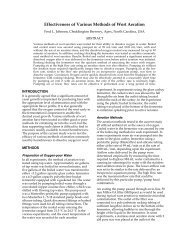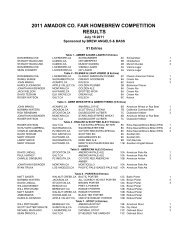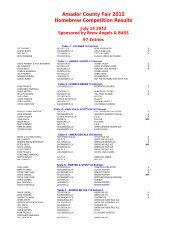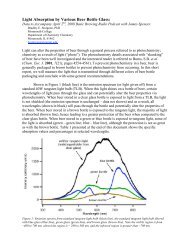A Homebrewer's Guide to Beer Flavor Descriptors - Brew Angels
A Homebrewer's Guide to Beer Flavor Descriptors - Brew Angels
A Homebrewer's Guide to Beer Flavor Descriptors - Brew Angels
You also want an ePaper? Increase the reach of your titles
YUMPU automatically turns print PDFs into web optimized ePapers that Google loves.
These various odors and tastes, composed of<br />
sulfides, thiols (terpenoids and mercaptans) and<br />
thioesters are formed, <strong>to</strong> different degrees, depending<br />
upon the malt, hops, processing procedures<br />
and yeast strain being used. How these<br />
compounds are formed and how they can be controlled<br />
is the subject of the rest of this report.<br />
During the brewing process, small but desirable<br />
amounts of sulfur dioxide (SO₂) are produced,<br />
usually less than 10 milligrams per liter (parts per<br />
million—ppm). Because it takes over 2O milligrams<br />
per liter for SO₂ <strong>to</strong> be detected by odor or taste,<br />
producing a sharp, biting sulfurous odor, the only<br />
effect this naturally occurring SO₂ has is <strong>to</strong> help<br />
retard harmful oxidative changes that impair<br />
fresh beer flavor and shorten shelf life.<br />
Therefore, <strong>to</strong> maintain as much natural SO₂ in<br />
the beer as possible, keep oxygen out of the wort<br />
and the beer when brewing, except for aerating<br />
prior <strong>to</strong> pitching the yeast. Some brewers add<br />
additional SO₂ <strong>to</strong> beer, in the form of sulfite, <strong>to</strong> help<br />
maintain shelf life. However, if the <strong>to</strong>tal SO₂<br />
content exceeds 10 milligrams per liter at the time<br />
of packaging, a new Federal law effective Jan. 9,<br />
1987, requires a declaration of sulfite content on<br />
the label.<br />
Hydrogen sulfide (H₂S), the stuff that smells<br />
like rotten eggs, is detectable in beer at a level of 5<br />
micrograms per liter (parts per billion—ppb). Although<br />
a small amount of H₂S is produced during<br />
the kettle boil, more in the presence of copper ions,<br />
most of the H₂S found in beer is formed by yeast<br />
during fermentation; the amount can vary with<br />
the strain being used. Fortunately, almost all of<br />
the H₂S formed, along with other volatile sulfur<br />
compounds that are present, is driven off with the<br />
carbon dioxide (CO₂); even more is driven off with<br />
warmer ale fermentations than when making cool<br />
fermented lager beer.<br />
Flushing out these volatile off‐aroma compounds<br />
is the primary reason for maintaining low<br />
fermenter back pressure. In rare cases a pan<strong>to</strong>thenate<br />
or pyroxidine vitamin‐deficient wort<br />
results in interference with methionine biosynthesis<br />
(Wainwright, 1970) and an increase in H₂S<br />
formation. Mutant yeasts that have defective<br />
sulfur metabolic pathways also can produce excessive<br />
amounts of H₂S. Smelling the gases produced<br />
by your yeast during fermentation should give you<br />
a good idea of the sulfur characteristics you can expect<br />
in the final product.<br />
In addition, several varieties of bacteria, (Zymononas<br />
and Pectinatus, gram‐negative rods and<br />
Megasphaera, a gram‐negative coccus first isolated<br />
from spoiled beer in Finland in 1984) produce<br />
H₂S in finished beer. Of course, the best control<br />
against problems like this is sanitation.<br />
Mercaptans, which include thiols and terpenoids,<br />
produce some of the world’s strongest and<br />
most unpleasant odors often noticeable at levels<br />
less than 1 micrograms per liter. Sulfuring hops, a<br />
procedure no longer used in this country, often re<br />
sulted in the formation of terpenoids in the hop<br />
oils, producing a garlicky odor, or a s‐methylhexane<br />
thionate, a compound that has a cabbagelike<br />
odor and is detectable at a level of 0.3 micrograms<br />
per liter. Mercaptans also can be formed by the interaction<br />
of H₂S with other beer components.<br />
However, the one mercaptan odor in beer that<br />
is the most familiar is lightstruck or skunky. This<br />
is the result of light rays interacting with lightsensitive<br />
hop iso‐alpha acids <strong>to</strong> produce 3 methyl‐<br />
2 butene‐3 thiol (Kuroiwa and Hashimo<strong>to</strong>, 1961).<br />
There are at least three ways <strong>to</strong> help control<br />
this problem. The most common and effective is <strong>to</strong><br />
package the beer in brown bottles that screen out<br />
most of the damaging light rays—those that have a<br />
wavelength between 400 and 520 nanometers (nm).<br />
If you feel you must package your product in<br />
clear or green glass, completely enclose the bottles<br />
in the six‐pack and/or a sealed case. Finally, you<br />
SPECIAL ISSUE 1987 ZYMURGY 51






